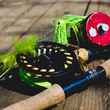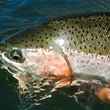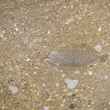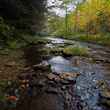Some fishermen I know are not only avid anglers, but accomplished amateur entomologists, ornithologists and botanists. I'm not one of them. Sure, I try to know my bugs because doing so has a direct tie to my success on the water, but I'm not much good when it comes to identifying birds or plants. It's not that I don't appreciate them, I do, I just haven't put in much of a study on them.
One plant that I can readily identify, however -- and one that a great number of other anglers can no doubt also spot even at a distance -- is the stinging nettle. Widespread throughout North America and Europe, the stinging nettle is quite often found growing along the edges of rivers and streams, where unsuspecting fishermen accidentally grasp or touch the plant while clambering up banks or sitting down for steam side break, only to be greeted by the nettle's intense, burning sting. As it turns out, though, nettles aren't all bad. Packed beneath those nasty stinging hairs is a great deal of nutrition, and stinging nettles aren't only edible, but delicious.
Not long ago, I was enjoying a drink with my wife at the bar at Southwark -- one of my home town of Philadelphia's finest eating and drinking establishments -- when a glance at the dinner menu revealed a dish of seared cod served atop a bed of stinging nettles. Much to my surprise, a few queries to the staff revealed these to be the same stinging nettles I repeatedly find a way to scorch my skin with when fishing my home waters, despite knowing full well where each and every patch of nettles is along the banks. That unwelcome sting poses no threat to diners however, as once cooked, nettles impart no sting whatsoever and, as noted, are quite delicious.
In fact, nettles are only a culinary oddity here in the states and are becoming less so fairly rapidly. In Europe, they're regularly found in soups, cheeses, sauces and more. They also make a hell of a pesto. The taste of nettles is commonly compared to that of spinach, but I find it to be much more complex and lively both in terms of flavor and texture.
Nutritionally, nettles are somewhat of a powerhouse. They are rich in vitamins A, C, D, iron, potassium, manganese, and calcium and are also packed with protein. At its peak, up to 25% of a nettle plant's dry weight can be protein, which is very high for a leafy green.
Nettles are likely beginning to poke their heads out through much of their range in the US, where they start emerging from the soils and seeking out sun in February and March. They're said to be at their best in the early spring but can be eaten throughout much of the spring and summer. Once the plant flowers, it is recommended that it not be eaten. If you're brave enough to experiment, you'll be rewarded. But, be sure you're identifying the plant correctly before picking it and to handle nettles with gloves that will protect you from the plant's bite. Once soaked, steamed, sautéed, mashed or frozen, the sting is neutralized and the nettles are ready for your recipes.
































Comments
ginkthefly replied on Permalink
Been gathering and eating nettles for a long time. They're fantastic in soups and I've even eaten them raw in salads after soaking them in ice water and drying them in a salad spinner.
SK replied on Permalink
I always love to see articles recognizing nettles. It is one of the most valuable plants in any garden. http://www.nettlesforhealth.com is a site loaded with information on the medicinal, scientific research, folk medicine traditions and some great recipes for nettles.
Chris replied on Permalink
Just the leaves, right?
Chad Shmukler replied on Permalink
Chris,
From what I understand (you should verify on your own), the stalks are edible too, but most people only eat the leaves.
Here are some google nettle videos about harvesting, cooking, recipes, etc.
http://www.richsoil.com/nettles.jsp
Pages